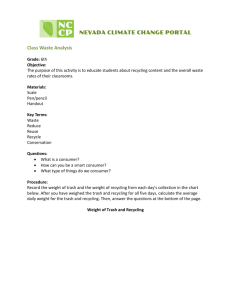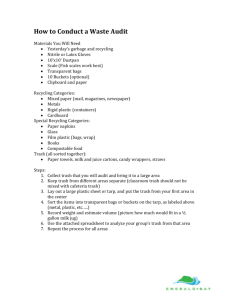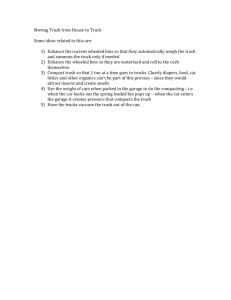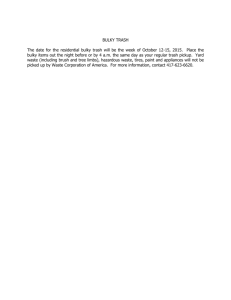PYP planner Planning the inquiry Class/grade: Kindergarten Age
advertisement
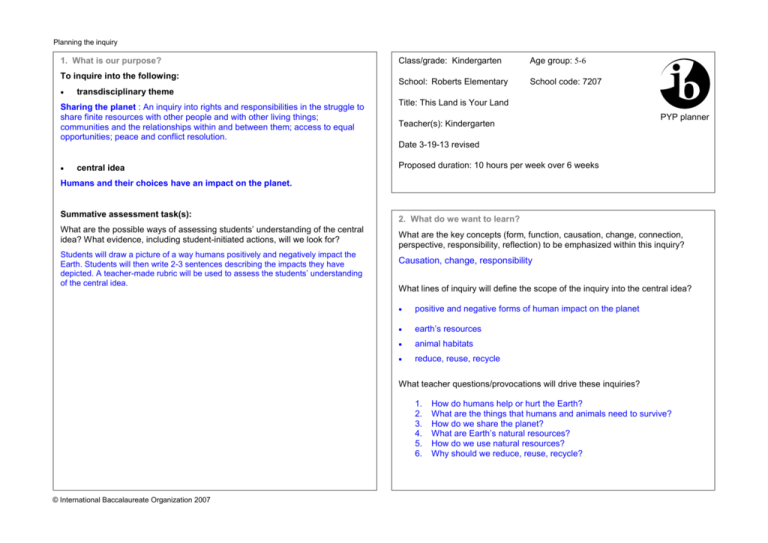
Planning the inquiry 1. What is our purpose? To inquire into the following: Age group: 5-6 School: Roberts Elementary School code: 7207 transdisciplinary theme Sharing the planet : An inquiry into rights and responsibilities in the struggle to share finite resources with other people and with other living things; communities and the relationships within and between them; access to equal opportunities; peace and conflict resolution. Class/grade: Kindergarten central idea Title: This Land is Your Land Teacher(s): Kindergarten PYP planner Date 3-19-13 revised Proposed duration: 10 hours per week over 6 weeks Humans and their choices have an impact on the planet. Summative assessment task(s): What are the possible ways of assessing students’ understanding of the central idea? What evidence, including student-initiated actions, will we look for? Students will draw a picture of a way humans positively and negatively impact the Earth. Students will then write 2-3 sentences describing the impacts they have depicted. A teacher-made rubric will be used to assess the students’ understanding of the central idea. 2. What do we want to learn? What are the key concepts (form, function, causation, change, connection, perspective, responsibility, reflection) to be emphasized within this inquiry? Causation, change, responsibility What lines of inquiry will define the scope of the inquiry into the central idea? positive and negative forms of human impact on the planet earth’s resources animal habitats reduce, reuse, recycle What teacher questions/provocations will drive these inquiries? 1. 2. 3. 4. 5. 6. © International Baccalaureate Organization 2007 How do humans help or hurt the Earth? What are the things that humans and animals need to survive? How do we share the planet? What are Earth’s natural resources? How do we use natural resources? Why should we reduce, reuse, recycle? Planning the inquiry 3. How might we know what we have learned? 4. How best might we learn? This column should be used in conjunction with “How best might we learn?” What are the learning experiences suggested by the teacher and/or students to encourage the students to engage with the inquiries and address the driving questions? What are the possible ways of assessing students’ prior knowledge and skills? What evidence will we look for? *Pre-assessment – the students will sort images of human impacts into columns titled positive or negative. What opportunities will occur for transdisciplinary skills development and for the development of the attributes of the learner profile? *Evidence –students will sort the images into the appropriate column and be able to explain their reasoning. What are the possible ways of assessing student learning in the context of the lines of inquiry? What evidence will we look for? *Students will name ways and items to recycle. *Students will share their decisions to positively impact the Earth during class share time. *Student’s actions will demonstrate their understanding of reducing. *Students will orally list some endangered animals. *Students will write their thoughts and feelings about human impacts in their journal. Frontloading – Students will walk into a classroom filled with recyclable and nonrecyclable litter and share their thoughts. They will then identify and sort recyclable items. (S, T, C, SM) Students will picture walk looking at endangered versus extinct animals. (T,C) The class will work together to create an “Endangered Species” book. This will create a discussion on what humans can do to take care of and protect animals.(R, C, S, SM) Teacher will show the video (What Happens to Garbage?) that demonstrates what happens to garbage after it leaves our homes/schools. (SM, R, T) Students will view the video of Magic School Bus – In the Rainforest. Students will then discuss how all parts of life are interconnected. (SM, R, T) At home, students will select an animal, where it is from, reasons for being endangered and what he can do to help.(R, SM, T) As a grade level, we will collect cans to recycle and use the funds to adopt an endangered animal. (SM, S, C, T) Students will identify ways to help conserve natural resources. (R, T, C) Trash Fashion Show- students create a Recycled/Reused garment or accessory at home to be worn in a school wide fashion show. (S, C, SM, R, T) Transdisiplinary Skills: *Noted on each activity below Profiles: Inquirer, Caring, Thinker, Principled, Knowledgeable, Reflective 5. What resources need to be gathered? What people, places, audio-visual materials, related literature, music, art, computer software, etc, will be available? Website: http://letsfindout.scholastic.com/game-archive http://www.brainpopjr.com/science/conservation/reducereuserecycle/preview.weml http://www.starfall.com/n/holiday/earthday/load.htm?f&n=main A Seed is a Promise; Panda Bear, Panda Bear, What Do You See by Carle; She’s Wearing a Dead Bird on Her Head; Shel Silversteins’ “Sarah, Cynthia, Silver Stout”; If I Ran the Rainforest; The Great Kapok Tree; The Lorax; Almost Gone; Will We Miss Them?; Using Nature’s Gifts; Too Much Trash; Why are Ice Caps Melting? Hodder Education PYP Inquiry Box “Recycling Our World” resource books Video – Where Does Garbage Go? ; Magic School Bus: In the Rainforest United Streaming video – “Forest Family for Forever” How will the classroom environment, local environment, and/or the community be used to facilitate the inquiry? Ozone Theater presentation and visit the local recycling center © International Baccalaureate Organization 2007 Reflecting on the inquiry 6. To what extent did we achieve our purpose? 7. To what extent did we include the elements of the PYP? Assess the outcome of the inquiry by providing evidence of students’ understanding of the central idea. The reflections of all teachers involved in the planning and teaching of the inquiry should be included. What were the learning experiences that enabled students to: The kids love talking and learning about endangered species. They are fascinated about this subject and want to know other ways to help the earth. A lot of action was sparked from this planner. In the science lab, the students made compost and the kids were really interested in how long it takes to turn into dirt. The Ozone Theatre was really good. The kids loved it. They learned a lot about air pollution, especially due to cars. They also love picking up trash around the school building. They become so aware and very adamant about putting trash in the correct place. They also really like the movie about where the trash goes. They have become so conscious of how much trash we make and how to reuse or recycle. The students participated in a trash fashion show where they reused trash to make clothing or accessory items. The students loved looking at the 1st grade recycling robots. Students also started asking questions about why the ice caps are melting? develop an understanding of the concepts identified in “What do we want to learn?” Causation: Created a report of an endangered animal Summative assessment allows students to identify a positive and negative impact humans have on the Earth Responsibility: Created Trash Fashion item to show reusing materials Donated to the can drive in order to adopt an endangered animal demonstrate the learning and application of particular transdisciplinary skills? Social: Present Trash Fashion to entire school body Communication and Research: Endangered Animal Report allows students to present information they have researched Thinking: Summative Assessment How you could improve on the assessment task(s) so that you would have a more accurate picture of each student’s understanding of the central idea. Self Management: Trash Fashion Show, students must walk respectfully through hallways and control their bodies and behaviors. We changed the focus of the assessment from problem and solution to positive and negative impacts in order to make it more aligned to our lines of inquiry. Students will draw a picture of a way humans positively and negatively impact the Earth. What was the evidence that connections were made between the central idea and the transdisciplinary theme? The students understood that recycling the cans helped keep our Earth clean and that using the funds to adopt an animal helped make a positive impact on animal population. © International Baccalaureate Organization 2007 develop particular attributes of the learner profile and/or attitudes? By independently choosing to clean up litter on the school grounds, the students demonstrated the following learner profiles and attitudes - Caring, Independence, Principled, Knowledgeable, Reflective, Thinker, Inquirer As students decide which animal should be adopted, they will demonstrate the following profiles and attributes: Caring, Appreciation, Cooperation, Thinker, Integrity, Empathy. Reflecting on the inquiry 8. What student-initiated inquiries arose from the learning? 9. Teacher notes Record a range of student-initiated inquiries and student questions and highlight any that were incorporated into the teaching and learning. Changes for next time: Maybe next year we actually get to the Recycling plant. The Arboretum has grade specific activities that would blend nicely with this unit. We didn’t sort trash this year, but it would be a good activity to bring back. Trash tells a lot about people. We also need to get the kids more involved at the school environment – maybe recycling school paper. It would be neat to study the recycling habits of different parts of the world. We need to team up with 1st grade and have a Robot parade or let them share their robots. 1. 2. 3. 4. 5. 6. 7. 8. 9. 10. 11. Can plants become endangered? What is smog? Why would people want to wear animal skins? Why not build all houses out of brick? What would happen if we run out of clean water? Why do people pollute their environment? How does air pollution hurt your lungs? Why do we need to save water? Why do hunters kill mommy animals? How do we stop people from killing endangered animals? Why do people destroy habitats? At this point teachers should go back to box 2 “What do we want to learn?” and highlight the teacher questions/provocations that were most effective in driving the inquiries. 1. How do humans help or hurt the Earth? What student-initiated actions arose from the learning? Record student-initiated actions taken by individuals or groups showing their ability to reflect, to choose and to act. Several families have started recycling at home due to student request. The students have taken it on themselves to pick up trash outside and keep the area clean. The students have also made an effort to use both sides of their paper in the art center. Students have started turning water off during brushing their teeth. © International Baccalaureate Organization 2007



